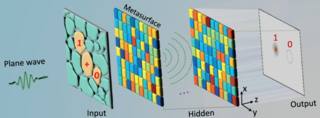Related Research Articles

Semiconductor Research Corporation (SRC), commonly known as SRC, is a high-technology research consortium active in the semiconductor industry. It is a leading semiconductor research consortium. Todd Younkin is the incumbent president and chief executive officer of the company.

An optical neural network (ONN) is a physical implementation of an artificial neural network with optical components.
Optical computing or photonic computing uses light waves produced by lasers or incoherent sources for data processing, data storage or data communication for computing. For decades, photons have shown promise to enable a higher bandwidth than the electrons used in conventional computers.
A photonic integrated circuit (PIC) or integrated optical circuit is a microchip containing two or more photonic components that form a functioning circuit. This technology detects, generates, transports, and processes light. Photonic integrated circuits utilize photons as opposed to electrons that are utilized by electronic integrated circuits. The major difference between the two is that a photonic integrated circuit provides functions for information signals imposed on optical wavelengths typically in the visible spectrum or near infrared (850–1650 nm).
Silicon photonics is the study and application of photonic systems which use silicon as an optical medium. The silicon is usually patterned with sub-micrometre precision, into microphotonic components. These operate in the infrared, most commonly at the 1.55 micrometre wavelength used by most fiber optic telecommunication systems. The silicon typically lies on top of a layer of silica in what is known as silicon on insulator (SOI).

William James Dally is an American computer scientist and educator. He is the chief scientist and senior vice president at Nvidia and was previously a professor of Electrical Engineering and Computer Science at Stanford University and MIT. Since 2021, he has been a member of the President's Council of Advisors on Science and Technology (PCAST).
Luxtera Inc., a subsidiary of Cisco Systems, is a semiconductor company that uses silicon photonics technology to build complex electro-optical systems in a production silicon CMOS process.

Michael Hochberg is an American physicist. He’s authored over 100 peer-reviewed journal articles, has founded several companies, and has been an inventor on over 60 patents. Hochberg's research interests include silicon photonics and large-scale photonic integration. He has worked in a number of application areas, including data communications, biosensing, quantum optics, mid-infrared photonics, optical computing, and machine learning. Much of his work in silicon photonics has been the product of a longstanding series of collaborations with Thomas Baehr-Jones.
In integrated circuits, optical interconnects refers to any system of transmitting signals from one part of an integrated circuit to another using light. Optical interconnects have been the topic of study due to the high latency and power consumption incurred by conventional metal interconnects in transmitting electrical signals over long distances, such as in interconnects classed as global interconnects. The International Technology Roadmap for Semiconductors (ITRS) has highlighted interconnect scaling as a problem for the semiconductor industry.
Andreessen Horowitz is a private American venture capital firm, founded in 2009 by Marc Andreessen and Ben Horowitz. The company is headquartered in Menlo Park, California. As of April 2023, Andreessen Horowitz ranks first on the list of venture capital firms by assets under management, with $42 billion as of May 2024.

Mellanox Technologies Ltd. was an Israeli-American multinational supplier of computer networking products based on InfiniBand and Ethernet technology. Mellanox offered adapters, switches, software, cables and silicon for markets including high-performance computing, data centers, cloud computing, computer data storage and financial services.
Arteris, Inc. is a multinational technology firm headquartered in Campbell, California. It develops the Network-on-Chip (NoC) on-chip interconnect IP and System-on-Chip (SoC) integration automation software used to create semiconductor designs for a variety of devices, particularly in automotive electronics, artificial intelligence/machine learning and consumer markets. The company specializes in the development and distribution of Network-on-Chip (NoC) interconnect Intellectual Property (IP) and SoC integration automation products used in the development of systems-on-chip.

Brainly is an education company based in Kraków, Poland, with headquarters in New York City. It is an AI-powered homework help platform targeting students and parents. As of November 2020, Brainly reported having 15 million daily active users, making it the world's most popular education app. In 2024, FlexOS reported Brainly as the #1 Generative AI Tool in the education category and the #6 Generative AI Tool overall. Also in 2024, Andreessen Horowitz reported Brainly as #6 in the Top 50 Gen AI Mobile Apps by monthly active users.

Magic Leap, Inc. is an American technology company that released a head-mounted augmented reality display, called Magic Leap One, which superimposes 3D computer-generated imagery over real world objects. It is attempting to construct a light-field chip using silicon photonics.

Tensor Processing Unit (TPU) is an AI accelerator application-specific integrated circuit (ASIC) developed by Google for neural network machine learning, using Google's own TensorFlow software. Google began using TPUs internally in 2015, and in 2018 made them available for third-party use, both as part of its cloud infrastructure and by offering a smaller version of the chip for sale.

Graphcore Limited is a British semiconductor company that develops accelerators for AI and machine learning. It has introduced a massively parallel Intelligence Processing Unit (IPU) that holds the complete machine learning model inside the processor.
Luminar Technologies Inc. is an American technology company that develops vision-based lidar and machine perception technologies, primarily for self-driving cars. The company's headquarters and main research and development facilities are in Orlando, Florida; a second major office is located in Palo Alto, California.

Keren Bergman is an American electrical engineer who is the Charles Batchelor Professor at Columbia University. She also serves as the director of the Lightwave Research Laboratory, a silicon photonics research group at Columbia University. Her research focuses on nano-photonics and particularly optical interconnects for low power, high bandwidth computing applications.

Cerebras Systems Inc. is an American artificial intelligence company with offices in Sunnyvale and San Diego, Toronto, Tokyo and Bangalore, India. Cerebras builds computer systems for complex artificial intelligence deep learning applications.
Fable Studio is a startup media company founded in January 2018 by Edward Saatchi and Pete Billington. It specializes in virtual reality media, and is using generative AI to develop a simuated reality titled the Simulation, and a streaming platform called Showrunner that can generate custom episodes.
References
- 1 2 "Startup accelerates progress toward light-speed computing". MIT News | Massachusetts Institute of Technology. 1 March 2024.
- ↑ "Lightmatter". Golden.
- ↑ Coldewey, Devin (5 February 2018). "Lightmatter aims to reinvent AI-specific chips with photonic computing and $11M in funding". TechCrunch.
- ↑ Coldewey, Devin (6 May 2021). "Lightmatter's photonic AI ambitions light up an $80M B round". TechCrunch.
- ↑ Coldewey, Devin (31 May 2023). "Lightmatter's photonic AI hardware is ready to shine with $154M in new funding". TechCrunch.
- ↑ Patel, Dylan. "Beyond Advanced Packaging: Lightmatter Passage Chiplets Co-Packaged On Optical Interposer". www.semianalysis.com.